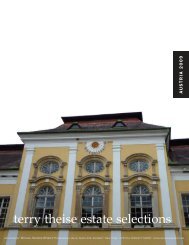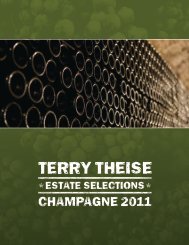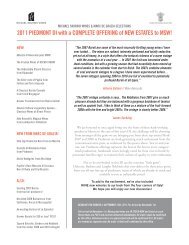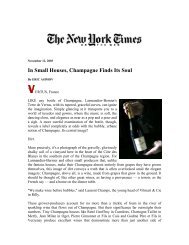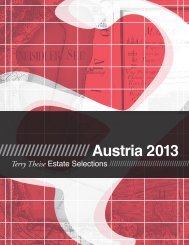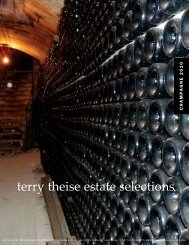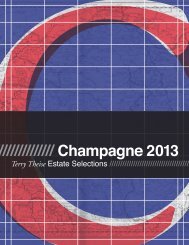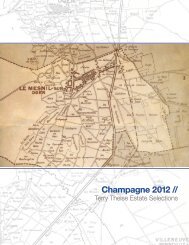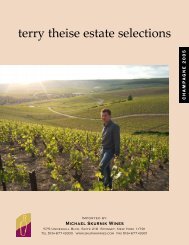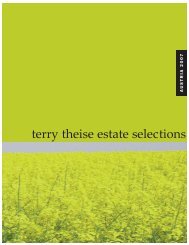German Catalog 2006 USE THIS ONE.qxp - Michael Skurnik Wines
German Catalog 2006 USE THIS ONE.qxp - Michael Skurnik Wines
German Catalog 2006 USE THIS ONE.qxp - Michael Skurnik Wines
You also want an ePaper? Increase the reach of your titles
YUMPU automatically turns print PDFs into web optimized ePapers that Google loves.
RHEINGAU WINES<br />
146<br />
On August 4th, 2003, my first day working in<br />
the vineyards of Johannes Leitz, it was well over<br />
100 degrees Fahrenheit. Johannes had just<br />
returned from vacation and the rows in the<br />
Rüdesheimer Berg Schlossberg resembled the<br />
maverick hairdo of a fifteen year-old kid with a<br />
rock-and-roll agenda. From where I was perched<br />
steeply above the confluence of the Rhine and<br />
Nahe rivers (both of which were lower than anyone<br />
could remember) the water barely managed a<br />
glimmer through the haze of the heat. As<br />
Johannes demonstrated how to go about green<br />
harvesting, I was crouched in the slightly less<br />
scorching shadow that the vines offered, mindfully<br />
cautious not to lose my footing on the dry red slate<br />
as I followed along down the precipitous vineyard<br />
slope which at times felt more like a precipice. You<br />
see, looking at the Rüdesheimer Berg vineyards,<br />
driving through them, even walking through them<br />
cannot prepare you for actually attempting to work<br />
in them for the first time (the incredible heat of<br />
2003 notwithstanding).<br />
As Johannes established the guidelines for<br />
how to tackle the vines, I realized immediately that<br />
I was at a great disadvantage. Not only does this<br />
man have a fourteen foot arm span (thus needing<br />
to adjust his footing far less than I, which is a not<br />
insubstantial consideration when the majority of<br />
one’s time is spent trying to navigate the precarious<br />
balance between remaining upright and the<br />
backward-downward pull of gravity) but his hands<br />
are at least twice the size of the average man and<br />
are seemingly capable of doing three things at one<br />
time. Remember how fascinating it was when the<br />
Tasmanian Devil would go whizzing through the<br />
forest on Saturday morning cartoons? Johannes<br />
moves nearly as fast, definitely with as much precision,<br />
and with all the calm of a person knitting<br />
wool hats for the village orphans. Meanwhile (and<br />
I’m ashamed to report that this is not a joke) I was<br />
completing one row to his every four. I tried to<br />
keep up for about the first fifteen minutes . . . .<br />
The process of green harvest is pretty common<br />
sense: pull away excessive leaf growth, clean out<br />
anything either dry or rotting and, most importantly,<br />
inspect the grapes. Johannes’ instructions were<br />
to leave only two perfectly healthy bunches per vine<br />
shoot which sounded fine until I quickly discovered<br />
Harvest at Leitz<br />
by Corrie Malas<br />
that this meant that no less than 50% (and in many<br />
cases much more) of the what the vine had yielded<br />
was left on the “floor.” I was shocked by this and<br />
almost a little scared. Would my friend have anything<br />
left to harvest if we were this rigorous in our<br />
green harvest selection? The Farmer replied, “No<br />
Corrie, when I am honest I must say that you are<br />
not cutting away enough . . .” Everyone talks about<br />
selection at harvest but the amount of selection<br />
Corrie amongst the vines<br />
that took place in these vineyards months before<br />
harvest was positively mind-bending. And as it has<br />
since been revealed, the vintners who worked this<br />
way in 2003 have wines that share the same mineral<br />
intensity, brilliant length and overall concentration<br />
that I so admire in Leitz’s collection this year.<br />
On the following days we worked Leitz’s other<br />
Rüdesheimer Berg vineyards: Roseneck (the<br />
steepest portion where I finally did fall, helplessly<br />
skidding down the quartzite slope until I figured<br />
out how to use my elbows as breaks), Rottland,<br />
Bischofsberg and Drachenstein. I got a little faster<br />
in my work. Johannes followed along after me less<br />
and I learned how to agreeably drink sparkling<br />
water by the liter. Each vineyard was left looking<br />
tidy and serious, well-prepared for the last portion<br />
of <strong>German</strong>y’s hottest summer in 500 years. Every<br />
day seemed hotter than the one that preceded it,<br />
perhaps because it was hotter or perhaps because<br />
there was no escaping the heat in the 95 degree<br />
nights, where I would lay exhausted, the heat like<br />
an immovable — almost smothering — blanket,<br />
without air conditioning or fans, drifting off to<br />
sleep feeling the weight of the grapes in my hands.



